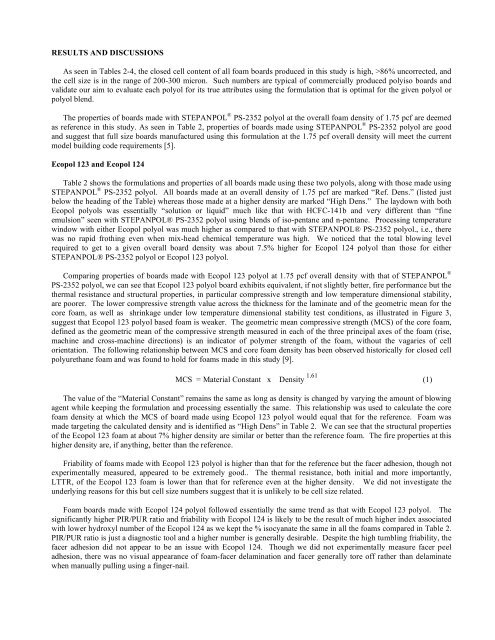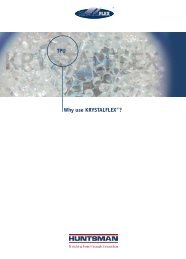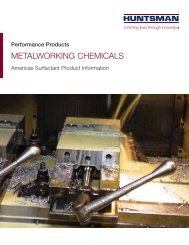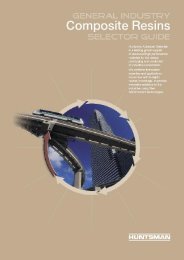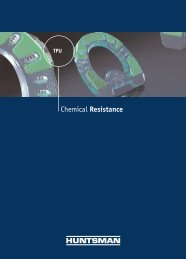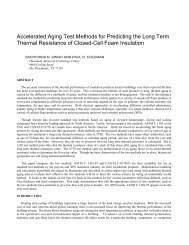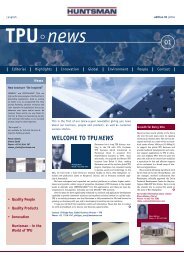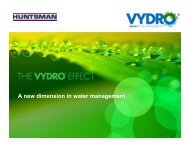New Developments in Polyisocyanurate Laminate Foam - Huntsman
New Developments in Polyisocyanurate Laminate Foam - Huntsman
New Developments in Polyisocyanurate Laminate Foam - Huntsman
Create successful ePaper yourself
Turn your PDF publications into a flip-book with our unique Google optimized e-Paper software.
RESULTS AND DISCUSSIONS<br />
As seen <strong>in</strong> Tables 2-4, the closed cell content of all foam boards produced <strong>in</strong> this study is high, >86% uncorrected, and<br />
the cell size is <strong>in</strong> the range of 200-300 micron. Such numbers are typical of commercially produced polyiso boards and<br />
validate our aim to evaluate each polyol for its true attributes us<strong>in</strong>g the formulation that is optimal for the given polyol or<br />
polyol blend.<br />
The properties of boards made with STEPANPOL ® PS-2352 polyol at the overall foam density of 1.75 pcf are deemed<br />
as reference <strong>in</strong> this study. As seen <strong>in</strong> Table 2, properties of boards made us<strong>in</strong>g STEPANPOL ® PS-2352 polyol are good<br />
and suggest that full size boards manufactured us<strong>in</strong>g this formulation at the 1.75 pcf overall density will meet the current<br />
model build<strong>in</strong>g code requirements [5].<br />
Ecopol 123 and Ecopol 124<br />
Table 2 shows the formulations and properties of all boards made us<strong>in</strong>g these two polyols, along with those made us<strong>in</strong>g<br />
STEPANPOL ® PS-2352 polyol. All boards made at an overall density of 1.75 pcf are marked “Ref. Dens.” (listed just<br />
below the head<strong>in</strong>g of the Table) whereas those made at a higher density are marked “High Dens.” The laydown with both<br />
Ecopol polyols was essentially “solution or liquid” much like that with HCFC-141b and very different than “f<strong>in</strong>e<br />
emulsion” seen with STEPANPOL® PS-2352 polyol us<strong>in</strong>g blends of iso-pentane and n-pentane. Process<strong>in</strong>g temperature<br />
w<strong>in</strong>dow with either Ecopol polyol was much higher as compared to that with STEPANPOL® PS-2352 polyol., i.e., there<br />
was no rapid froth<strong>in</strong>g even when mix-head chemical temperature was high. We noticed that the total blow<strong>in</strong>g level<br />
required to get to a given overall board density was about 7.5% higher for Ecopol 124 polyol than those for either<br />
STEPANPOL® PS-2352 polyol or Ecopol 123 polyol.<br />
Compar<strong>in</strong>g properties of boards made with Ecopol 123 polyol at 1.75 pcf overall density with that of STEPANPOL ®<br />
PS-2352 polyol, we can see that Ecopol 123 polyol board exhibits equivalent, if not slightly better, fire performance but the<br />
thermal resistance and structural properties, <strong>in</strong> particular compressive strength and low temperature dimensional stability,<br />
are poorer. The lower compressive strength value across the thickness for the lam<strong>in</strong>ate and of the geometric mean for the<br />
core foam, as well as shr<strong>in</strong>kage under low temperature dimensional stability test conditions, as illustrated <strong>in</strong> Figure 3,<br />
suggest that Ecopol 123 polyol based foam is weaker. The geometric mean compressive strength (MCS) of the core foam,<br />
def<strong>in</strong>ed as the geometric mean of the compressive strength measured <strong>in</strong> each of the three pr<strong>in</strong>cipal axes of the foam (rise,<br />
mach<strong>in</strong>e and cross-mach<strong>in</strong>e directions) is an <strong>in</strong>dicator of polymer strength of the foam, without the vagaries of cell<br />
orientation. The follow<strong>in</strong>g relationship between MCS and core foam density has been observed historically for closed cell<br />
polyurethane foam and was found to hold for foams made <strong>in</strong> this study [9].<br />
MCS = Material Constant x Density 1.61 (1)<br />
The value of the “Material Constant” rema<strong>in</strong>s the same as long as density is changed by vary<strong>in</strong>g the amount of blow<strong>in</strong>g<br />
agent while keep<strong>in</strong>g the formulation and process<strong>in</strong>g essentially the same. This relationship was used to calculate the core<br />
foam density at which the MCS of board made us<strong>in</strong>g Ecopol 123 polyol would equal that for the reference. <strong>Foam</strong> was<br />
made target<strong>in</strong>g the calculated density and is identified as “High Dens” <strong>in</strong> Table 2. We can see that the structural properties<br />
of the Ecopol 123 foam at about 7% higher density are similar or better than the reference foam. The fire properties at this<br />
higher density are, if anyth<strong>in</strong>g, better than the reference.<br />
Friability of foams made with Ecopol 123 polyol is higher than that for the reference but the facer adhesion, though not<br />
experimentally measured, appeared to be extremely good.. The thermal resistance, both <strong>in</strong>itial and more importantly,<br />
LTTR, of the Ecopol 123 foam is lower than that for reference even at the higher density. We did not <strong>in</strong>vestigate the<br />
underly<strong>in</strong>g reasons for this but cell size numbers suggest that it is unlikely to be cell size related.<br />
<strong>Foam</strong> boards made with Ecopol 124 polyol followed essentially the same trend as that with Ecopol 123 polyol. The<br />
significantly higher PIR/PUR ratio and friability with Ecopol 124 is likely to be the result of much higher <strong>in</strong>dex associated<br />
with lower hydroxyl number of the Ecopol 124 as we kept the % isocyanate the same <strong>in</strong> all the foams compared <strong>in</strong> Table 2.<br />
PIR/PUR ratio is just a diagnostic tool and a higher number is generally desirable. Despite the high tumbl<strong>in</strong>g friability, the<br />
facer adhesion did not appear to be an issue with Ecopol 124. Though we did not experimentally measure facer peel<br />
adhesion, there was no visual appearance of foam-facer delam<strong>in</strong>ation and facer generally tore off rather than delam<strong>in</strong>ate<br />
when manually pull<strong>in</strong>g us<strong>in</strong>g a f<strong>in</strong>ger-nail.


